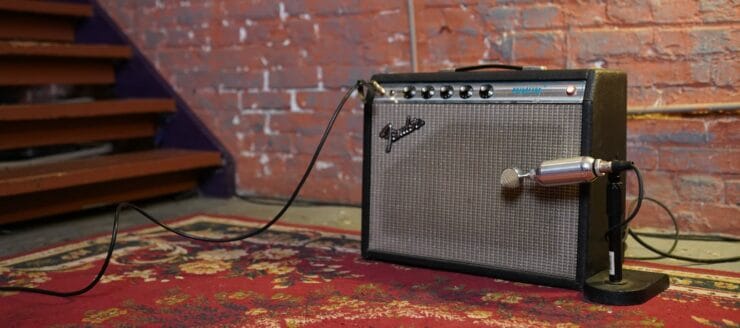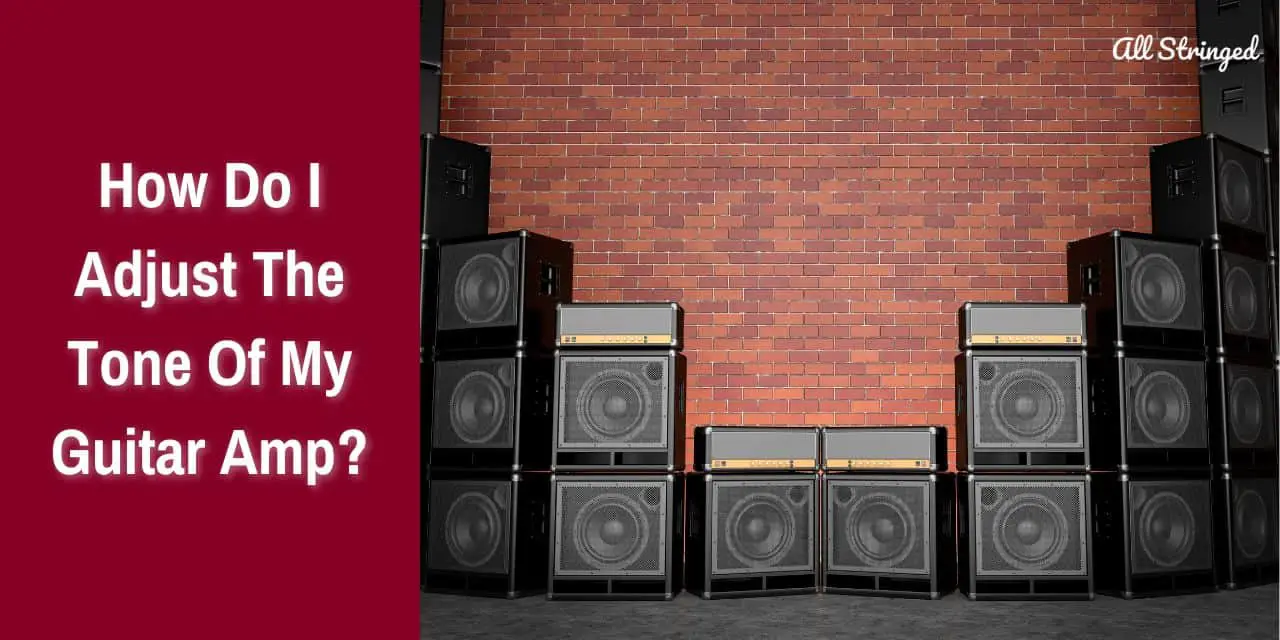Are you a guitar player looking for a little more control over your tone? Adjusting the tone of your guitar amp can make all the difference in getting the sound you want. In this article, we will discuss the basics of how to adjust the tone of your amp to get the sound that you are looking for. If you are ready to take your tone to the next level, read on and learn the basics of how to adjust the tone of your guitar amp!
Definition and impact of tone in sound
When talking about music and sound, tone refers to the quality, character, or timbre of a sound. It is an important element that influences the overall perception and emotional impact of music. Understanding the concept of tone and its effect on sound can deepen your appreciation and interaction with various musical compositions.
>>> Click here to read our review about the Top 15 Best Guitar Amps <<<
Tone can be defined as the distinct quality or coloration of a sound that differentiates it from others. The tone is what gives an instrument, voice, or sound its unique identity. Think of it as the sonic fingerprint that allows you to distinguish between a guitar and a piano or a soprano and a tenor voice. Each sound source possesses its tonal characteristics, resulting in a rich tapestry of a musical expression. There are different ways in which tone impacts sound in guitar amps including timbre, character, emotional impact, artistic expression, and more.
Tone plays a key role in determining the timbre and character of a sound. Timbre refers to the unique blend of harmonics and overtones that give a sound its particular texture and color. It is what makes a piano sound different from a violin, even when playing the same note. The distinct combination of harmonics and overtones contributes to the tonal richness and complexity of an instrument or voice.
Tone also has a profound impact on the emotional response elicited from music. Different tones can evoke various emotions, such as joy, anger, sadness, or tranquility. For instance, a bright and cheerful tone produced by a trumpet can convey a sense of celebration or excitement, whereas a mellow and smooth tone from a saxophone can evoke feelings of relaxation or nostalgia. The tonal qualities of a musical piece contribute to its overall mood and emotional resonance.
Musicians, guitarists, and composers utilize tone to express their artistic intentions and convey specific messages. The selection of instruments, voice types, and sound textures allows them to shape the sonic landscape and communicate their creative vision. By manipulating tone, musicians will be able to create contrasts, convey meaning, and evoke specific atmospheres within a musical composition.
Tone also heavily influences the selection of musical instruments for a particular piece. Each instrument has its own unique tonal characteristics and musicians choose instruments based on the desired sonic qualities. For instance, a harp might be chosen for its ethereal and delicate tone in a serene composition whereas an electric guitar might be selected for its edgy and distorted tone in a rock song. The tonal palette of instruments offers endless possibilities for artistic expression and sonic exploration.

How do I adjust the tone of my guitar amp?
As a musician or guitarist, having control over the tone of your guitar amp will be important for crafting your desired sound. When it comes to playing the guitar, achieving the desired tone is a top priority for many guitarists. While the choice of guitar and effects pedals play a significant role, the guitar amp itself holds tremendous power in shaping the overall sound. Whether you are looking for a clean and warm tone for jazz, a gritty crunch for rock, or a high-gain distortion for metal, understanding how do I adjust the tone of my guitar amp will be important.
Here are some of the different ways you can adjust the tone of your guitar amp. Understanding how the controls work and how you can manipulate them effectively will help you unlock your desired sonic palette and achieve the desired sonic characteristics.
#1. Adjust the EQ settings
First, you need to understand the tone controls. Most guitar amps feature a set of common tone controls that allow you to shape the frequency response of your guitar’s sound. The EQ (Equalization) controls on a guitar amp allow precise adjustment of the frequency response, enabling the shaping of the tonal characteristics. They typically include bass, middle, treble, and presence controls.
Adjusting the bass control will allow you to boost or cut the low-frequency content of your guitar’s sound. Increasing the bass can add warmth and depth whereas reducing it will provide a tighter and more focused tone.
The middle control affects the mid-range frequencies, which are crucial for defining the guitar’s presence and clarity. Boosting the middle can offer a more pronounced and cutting tone while cutting it will create a scooped or more vintage sound.
The treble control influences the high-frequency content of your guitar’s sound. Boosting the treble can result in a brighter and more articulate tone. Meanwhile, cutting it can produce a mellower or smoother sound.
Some amps also come with a presence control, which affects the upper mid-range and high-frequency response. Increasing the presence adds definition and clarity while decreasing it creates a softer and more rounded sound.
Experimenting with different combinations of EQ settings will allow you to tailor the tonal balance to suit your playing style and genre.
#2. Adjust the gain
The gain control or also known as the “drive” or “distortion”, control will determine the level of overdrive or distortion in your guitar signal. Adjusting the gain setting will significantly impact your tone.
Lower gain settings result in a cleaner and more transparent sound, suitable for genres like jazz, blues, or clean rhythm playing. Moderate gain settings introduce a touch of crunch and sustain ideal for classic rock or rhythm guitar parts that require grit and punch. Higher gain settings produce heavy distortion and sustain, which is perfect for genres like hard rock, metal, or for lead guitar solos that demand power and aggression.
#3. Adjust the presence
The presence control affects the upper mid-range and high-frequency response. It provides the final touch to your overall tone. Increasing the presence control can add brightness, definition, and cut to your sound. This is especially useful when playing in a band setting as it helps your guitar stand out in the mix.
Decreasing the presence control can result in a smoother and more rounded tone. This setting is suitable for creating a vintage or warmer sound. By fine-tuning the presence control, you’ll be able to further shape the tonal clarity, articulation, and projection of your guitar.
#4. Tinker with flat settings
Before you make adjustments, it is considered a good practice to start with all tone controls set to their flat or neutral positions (usually around the 12 o’clock position). This ensures a balanced starting point and allows you to make more intentional changes to your tone.
#5. Balance the controls
As you make adjustments to the tone controls, you should keep in mind the overall balance of your sound. Aim for a well-rounded tone where no frequency range is overpowering. For instance, if you boost the bass, consider reducing the treble slightly to maintain a balanced sound.
#6. Take room acoustics into account
Remember that the acoustics of your playing environment can influence how your tone is perceived. If you are playing in a room with excessive bass resonance, you might have to reduce the bass control to compensate. Similarly, if the room is very bright, you may want to decrease the treble control slightly.

#7. Experimentation and personal preference
Adjusting the tone of your guitar amp is a highly subjective process and personal preference plays a key role. You shouldn’t be afraid to experiment and trust your ears. Explore different combinations of EQ settings until you find the sweet spot that matches your desired sound and playing style.
Different types of guitar amps
Choosing the right guitar amp is important for achieving the desired tone and maximizing your playing experience. With a wide variety of options available, it is important to understand the differences between these amps. Each of these amps comes with its own characteristics and they cater to specific needs and tonal preferences. Here are some of the different types of guitar amps available for musicians and guitarists and their distinctive sonic characteristics.
#1. Tube amps
Tube amps have a long-standing legacy in the world of guitar amplification. These amps make use of vacuum tubes to amplify the guitar signal. They are highly regarded for their warm and responsive tone. Moreover, they produce rich harmonics and natural compression, delivering a dynamic sound that responds sensitively to your playing nuances.
When pushed hard, tube amps generate pleasing and musical overdrive, which is highly sought after in genres like blues, rock, and classic rock. Tube amps often offer higher power ratings and greater headroom, which makes them suited for live performances and larger venues.
These amps require periodic maintenance, including tube replacements, and tend to be more expensive compared to other types of amps. Tube amps are best suited for musicians who prioritize vintage tone, organic feel, and natural overdrive in their playing.
#2. Solid-state amps
Solid-state amps employ solid-state electronics, such as diodes and transistors, to amplify the guitar signal. These amps are known for their reliability and durability, as they have no delicate vacuum tubes that need frequent replacements.
Solid-state amps offer a clean and focused tone, with high-definition clarity across the frequency spectrum. They’re particularly suitable for genres that require pristine sound reproduction, such as jazz, country, and more.
These amps are generally lighter and more portable than tube amps, which makes them quite convenient for gigs and rehearsals. Solid-state amps are often more affordable compared to tube amps, which makes them a popular choice for beginners and budget-conscious musicians. Solid-state amps are best suited for musicians looking for clean, precise tones, durability, and affordability.
#3. Digital modeling amps
Digital modeling amps make use of advanced digital technology for replicating the sound characteristics of various amps, cabinets, and effects. These amps offer an extensive range of tones and effects, allowing you to emulate different amp models, cabinets, and effects pedals. They offer versatility for exploring various genres and sonic possibilities.
Many digital modeling amps integrate multiple amp models, effects, and recording capabilities into a single unit, making them perfect for home studios or musicians on the go. They often come with preset settings and the ability to customize and save your own tones, providing quick access to your preferred sounds.
Some digital modeling amps include built-in learning features, metronomes, and recording interfaces, enhancing the learning and recording experience. These amps are best suited for musicians who desire a wide range of tones, effects, and convenience in a compact package.
#4. Hybrid amps
Hybrid amps combine the best of tube amps and solid-state amps by blending their technologies. They typically feature a tube preamp section combined with a solid-state power amp. Hybrid amps aim to capture the warm and responsive tone of tube amps while offering the reliability and affordability of solid-state amps. They offer a versatile range of tones suitable for various genres.
These amps also include built-in circuitry to simulate the characteristics of tube power amps, adding a touch of tube-like warmth and saturation to the sound. They are generally lighter and more portable than full tube amps, which makes them a convenient option for gigging musicians.
#5. Boutique and hand-wired amps
Boutique and hand-wired amps are highly sought after by tone enthusiasts and professional musicians. These amps are typically crafted by small-scale manufacturers and emphasize meticulous construction and attention to detail. Boutique and hand-wired amps are meticulously assembled using high-quality components, which results in superior sound quality and craftsmanship.
These amps often possess unique voicings and tonal signatures, offering a rich and distinct sound that appeals to discerning guitarists. Many boutique amp manufacturers offer customization options, allowing musicians to tailor the amp’s specifications, including power rating, speaker selection, and circuit design.
#6. Vintage amps
Vintage amps refer to amps that were manufactured in the years gone by and are highly sought-after for their historical significance and unique tonal qualities. Vintage tones can range from classic tube amps to early solid-state models. These amps offer a specific tonal character associated with the era in which they were produced. Vintage tube amps, in particular, are highly revered for their warm, dynamic, and vintage-inspired tones.
These amps often have a high collectible value due to their scarcity, historical significance, and desirability among musicians and collectors. Owning a vintage amp might require extra care as older components might require maintenance or replacement to ensure optimal performance.
#7. Modeling combos
While digital modeling amps have gained a lot of popularity, there are also modeling combos available that offer an all-in-one solution. These combos combine a traditional solid-state or tube power amp with digital modeling technology.
Modeling combos emulate the sound characteristics of various amps, cabinets, and effects, which allows for a wide range of tones and sonic versatility. They provide a compact and portable solution, integrating multiple amp models, effects, and often speaker simulation, which makes them suitable for practice, home recording, and small gigs. They typically feature intuitive controls and presets, enabling quick and easy access to different tones.
Tips for adjusting tone in your guitar amp
Adjusting the tone of your guitar or instrument is an art that requires a keen ear, experimentation, and a solid understanding of various settings. With every musician or guitarist striving for a unique and personal sound, using reference tracks and experimenting with different settings will be invaluable tools in achieving the desired tone. Here are a few tips that will come in handy and help you master the art of adjusting tone to perfection.
Using a reference track
Making use of reference tracks, which are recordings of professionally mixed and mastered songs in a similar genre or style can provide a benchmark for achieving the desired tone. Go to websites like YouTube and choose tracks that exhibit the tonal qualities and characteristics you aim to achieve. Pay close attention to the guitar tone, EQ balance, dynamics, and overall sonic texture.
Listen attentively to the reference tracks, focusing on specific elements like the guitar’s presence, brightness, warmth, or depth. Analyze how these elements contribute to the overall mix and how they interact with other instruments.
A/B comparison will be key. Listen to your own recordings or live sound and compare them with the reference tracks. Take note of the differences and identify areas where the tone falls short. This will help guide your adjustments.
Make incremental changes to the tone based on the reference tracks. Experiment with different settings, such as EQ, gain, presence, or effects to get closer to the desired tonal qualities.
Experiment with settings
While reference tracks serve as a guide, experimenting with different settings is the hands-on approach to fine-tuning your tone. Experiment with EQ controls on your guitar, pedals, or amplifier. Make subtle adjustments to the bass, treble, and mid frequencies to shape the tonal balance. Increase the bass for added warmth, boost the midrange for presence, or adjust the treble for brightness.
Experiment with different gain settings for achieving the desired level of overdrive or distortion. Increase the gain for a heavier and more saturated tone or dial it back for a cleaner and more transparent sound.
Explore the presence control on your amp or pedals to fine-tune the upper mid-range and high-frequency response. Adjusting the presence can enhance clarity, articulation, and projection. Experiment with different effects pedals and their settings to shape the tone. Explore the modulation effects, delays, reverbs, and more for adding depth, texture, and ambiance to your sound.
If possible, you should experiment with different speaker cabinets or mic placements to achieve the desired tonal characteristics. Each combination can have a significant impact on your overall tone. Consider the acoustics of your playing environment. Adjusting the tone to suit the room can compensate for any unwanted resonances or reflections that might affect your sound.
Trust your ears
While these tips serve as general guidelines, it is important to trust your ears throughout the adjustment process. Your personal taste and musical style play a key role in determining your ideal tone. Experimentation and careful listening will be key to finding your unique sound.
FAQs
What are the most common ways to adjust the tone of my guitar amp?
The main ways to adjust the tone of a guitar amp are by using the controls on the amplifier itself, such as the volume, treble, mid, and bass knobs. You can also adjust the tone of your amp by using external devices such as an equalizer, compressor, or effects pedal.
What is the best way to dial in the tone I’m looking for?
The best way to dial in the tone you’re looking for is to experiment with the controls on the amplifier itself, as well as any external devices you are using. Start by setting the volume to a comfortable level. Then, experiment with the treble, mid, and bass knobs to find the tone you’re looking for. If you are using an effects pedal, you can also adjust the settings on the pedal to shape the sound of your guitar.
What should I do if I’m having trouble adjusting my guitar amp’s tone?
If you are having trouble adjusting your amp’s tone, it may help to consult the user manual or reach out to a professional. They can provide tips and advice on how to best adjust your amp’s tone. You can also try searching online for tutorials or




